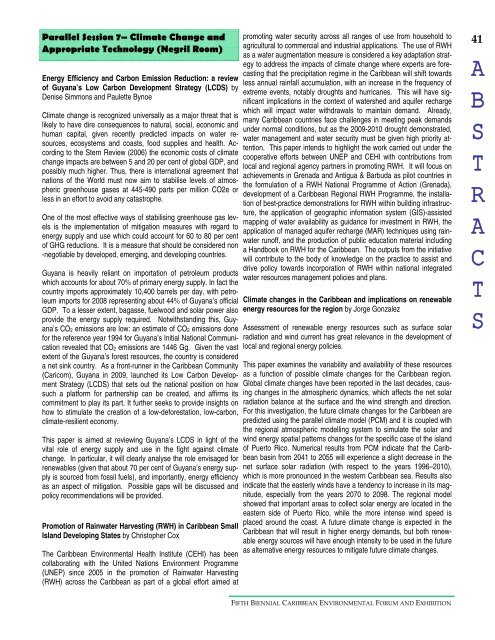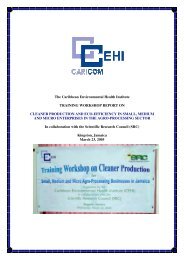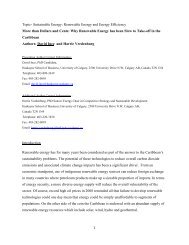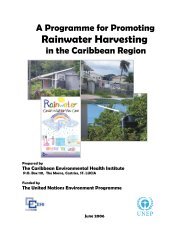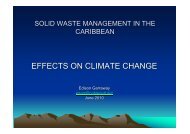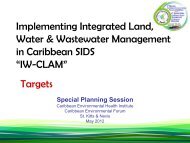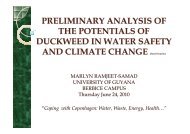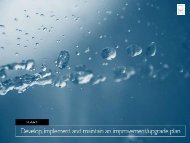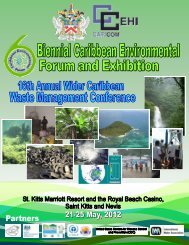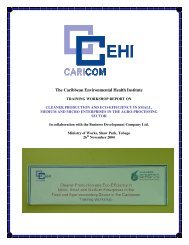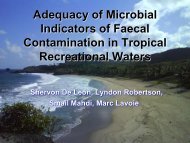conference magazine - Caribbean Environmental Health Institute
conference magazine - Caribbean Environmental Health Institute
conference magazine - Caribbean Environmental Health Institute
You also want an ePaper? Increase the reach of your titles
YUMPU automatically turns print PDFs into web optimized ePapers that Google loves.
Parallel Session 7– Climate Change and<br />
Appropriate Technology (Negril Room)<br />
Energy Efficiency and Carbon Emission Reduction: a review<br />
of Guyana’s Low Carbon Development Strategy (LCDS) by<br />
Denise Simmons and Paulette Bynoe<br />
Climate change is recognized universally as a major threat that is<br />
likely to have dire consequences to natural, social, economic and<br />
human capital, given recently predicted impacts on water resources,<br />
ecosystems and coasts, food supplies and health. According<br />
to the Stern Review (2006) the economic costs of climate<br />
change impacts are between 5 and 20 per cent of global GDP, and<br />
possibly much higher. Thus, there is international agreement that<br />
nations of the World must now aim to stabilise levels of atmospheric<br />
greenhouse gases at 445-490 parts per million CO2e or<br />
less in an effort to avoid any catastrophe.<br />
One of the most effective ways of stabilising greenhouse gas levels<br />
is the implementation of mitigation measures with regard to<br />
energy supply and use which could account for 60 to 80 per cent<br />
of GHG reductions. It is a measure that should be considered non<br />
-negotiable by developed, emerging, and developing countries.<br />
Guyana is heavily reliant on importation of petroleum products<br />
which accounts for about 70% of primary energy supply. In fact the<br />
country imports approximately 10,400 barrels per day, with petroleum<br />
imports for 2008 representing about 44% of Guyana’s official<br />
GDP. To a lesser extent, bagasse, fuelwood and solar power also<br />
provide the energy supply required. Notwithstanding this, Guyana’s<br />
CO2 emissions are low: an estimate of CO2 emissions done<br />
for the reference year 1994 for Guyana’s Initial National Communication<br />
revealed that CO2 emissions are 1446 Gg. Given the vast<br />
extent of the Guyana’s forest resources, the country is considered<br />
a net sink country. As a front-runner in the <strong>Caribbean</strong> Community<br />
(Caricom), Guyana in 2009, launched its Low Carbon Development<br />
Strategy (LCDS) that sets out the national position on how<br />
such a platform for partnership can be created, and affirms its<br />
commitment to play its part. It further seeks to provide insights on<br />
how to stimulate the creation of a low-deforestation, low-carbon,<br />
climate-resilient economy.<br />
This paper is aimed at reviewing Guyana’s LCDS in light of the<br />
vital role of energy supply and use in the fight against climate<br />
change. In particular, it will clearly analyse the role envisaged for<br />
renewables (given that about 70 per cent of Guyana’s energy supply<br />
is sourced from fossil fuels), and importantly, energy efficiency<br />
as an aspect of mitigation. Possible gaps will be discussed and<br />
policy recommendations will be provided.<br />
Promotion of Rainwater Harvesting (RWH) in <strong>Caribbean</strong> Small<br />
Island Developing States by Christopher Cox<br />
The <strong>Caribbean</strong> <strong>Environmental</strong> <strong>Health</strong> <strong>Institute</strong> (CEHI) has been<br />
collaborating with the United Nations Environment Programme<br />
(UNEP) since 2005 in the promotion of Rainwater Harvesting<br />
(RWH) across the <strong>Caribbean</strong> as part of a global effort aimed at<br />
promoting water security across all ranges of use from household to<br />
agricultural to commercial and industrial applications. The use of RWH<br />
as a water augmentation measure is considered a key adaptation strategy<br />
to address the impacts of climate change where experts are forecasting<br />
that the precipitation regime in the <strong>Caribbean</strong> will shift towards<br />
less annual rainfall accumulation, with an increase in the frequency of<br />
extreme events, notably droughts and hurricanes. This will have significant<br />
implications in the context of watershed and aquifer recharge<br />
which will impact water withdrawals to maintain demand. Already,<br />
many <strong>Caribbean</strong> countries face challenges in meeting peak demands<br />
under normal conditions, but as the 2009-2010 drought demonstrated,<br />
water management and water security must be given high priority attention.<br />
This paper intends to highlight the work carried out under the<br />
cooperative efforts between UNEP and CEHI with contributions from<br />
local and regional agency partners in promoting RWH. It will focus on<br />
achievements in Grenada and Antigua & Barbuda as pilot countries in<br />
the formulation of a RWH National Programme of Action (Grenada),<br />
development of a <strong>Caribbean</strong> Regional RWH Programme, the installation<br />
of best-practice demonstrations for RWH within building infrastructure,<br />
the application of geographic information system (GIS)-assisted<br />
mapping of water availability as guidance for investment in RWH, the<br />
application of managed aquifer recharge (MAR) techniques using rainwater<br />
runoff, and the production of public education material including<br />
a Handbook on RWH for the <strong>Caribbean</strong>. The outputs from the initiative<br />
will contribute to the body of knowledge on the practice to assist and<br />
drive policy towards incorporation of RWH within national integrated<br />
water resources management policies and plans.<br />
Climate changes in the <strong>Caribbean</strong> and implications on renewable<br />
energy resources for the region by Jorge Gonzalez<br />
Assessment of renewable energy resources such as surface solar<br />
radiation and wind current has great relevance in the development of<br />
local and regional energy policies.<br />
This paper examines the variability and availability of these resources<br />
as a function of possible climate changes for the <strong>Caribbean</strong> region.<br />
Global climate changes have been reported in the last decades, causing<br />
changes in the atmospheric dynamics, which affects the net solar<br />
radiation balance at the surface and the wind strength and direction.<br />
For this investigation, the future climate changes for the <strong>Caribbean</strong> are<br />
predicted using the parallel climate model (PCM) and it is coupled with<br />
the regional atmospheric modelling system to simulate the solar and<br />
wind energy spatial patterns changes for the specific case of the island<br />
of Puerto Rico. Numerical results from PCM indicate that the <strong>Caribbean</strong><br />
basin from 2041 to 2055 will experience a slight decrease in the<br />
net surface solar radiation (with respect to the years 1996–2010),<br />
which is more pronounced in the western <strong>Caribbean</strong> sea. Results also<br />
indicate that the easterly winds have a tendency to increase in its magnitude,<br />
especially from the years 2070 to 2098. The regional model<br />
showed that important areas to collect solar energy are located in the<br />
eastern side of Puerto Rico, while the more intense wind speed is<br />
placed around the coast. A future climate change is expected in the<br />
<strong>Caribbean</strong> that will result in higher energy demands, but both renewable<br />
energy sources will have enough intensity to be used in the future<br />
as alternative energy resources to mitigate future climate changes.<br />
41<br />
A<br />
B<br />
S<br />
T<br />
R<br />
A<br />
C<br />
T<br />
S<br />
FIFTH BIENNIAL CARIBBEAN ENVIRONMENTAL FORUM AND EXHIBITION


